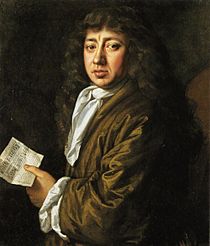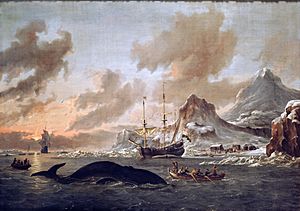William Batten facts for kids
Quick facts for kids
Sir
William Batten
|
|
|---|---|

|
|
| Master of Trinity House | |
| In office June 1663 – June 1664 |
|
| Member of Parliament for Rochester |
|
| In office May 1661 – October 1667 |
|
| Surveyor of the Navy | |
| In office 1638 to 1648 – 1660 to 1667 |
|
| Personal details | |
| Born | c. 1601 Easton in Gordano, Somerset, England |
| Died | 5 October 1667, age 66 (approximate) London, England |
| Resting place | St. Mary's Church, Walthamstow |
| Spouses | (1) Margaret Browne (1625–her death) (2) Elizabeth Turner (1659–his death) |
| Children | (1) William (1626–after 1675); Benjamin (1644-1684); Mary; Martha (1637–after 1667) |
| Occupation | Naval officer and administrator |
| Military service | |
| Allegiance | Parliamentarian 1642–1648; Royalist 1648 |
| Rank | Vice-admiral |
| Battles/wars |
|
Sir William Batten (born around 1601, died October 5, 1667) was an English naval officer. He started his career as a sailor on merchant ships. During the First English Civil War, he was the second-in-command of the Parliamentarian navy.
However, when the Second English Civil War began in 1648, he switched sides. He joined the Royalists, who supported the King. After King Charles II returned to power in 1660 (called the Stuart Restoration), Batten became a Member of Parliament for Rochester. He was also re-appointed as Surveyor of the Navy. This was a job he had held before, from 1638 to 1648. In this role, he worked with Samuel Pepys, who wrote about Batten often in his famous "Diary."
Contents
William Batten's Life
William Batten was born around 1601 in Easton in Gordano, Somerset, England. He was the second son of Andrew Batten, who was a Master mariner, meaning he commanded a merchant ship. William's older brother also worked in the merchant navy. He had at least one sister, who married Captain John Browne, another ship master. John Browne also served with Batten in the Parliamentarian navy.
In 1625, William Batten married Margaret Browne, who was John Browne's sister. They had six children together. At least four of their children lived longer than William. Their children included William (born 1626), Benjamin (born around 1644), Mary, and Martha (born 1637). Benjamin followed his father into the navy. Martha married William Castle, a shipwright. Margaret died in the 1650s. In 1659, Batten married again to Elizabeth Woodstocke. They did not have any children together.
Starting His Career at Sea
William Batten began his working life as an apprentice in London. An apprentice learns a trade from a skilled worker. He became a full member of the Worshipful Company of Merchant Taylors in 1623. However, he chose to follow his father and brother into the merchant marine. This meant working on ships that carried goods for trade.
In 1625, he commanded one of two whalers. These were ships sent to Spitsbergen to hunt whales. An Anglo-Spanish war started in 1625. In August 1626, Batten became captain of the "Salutation," an armed merchant ship. This ship had a special license, called a letter of marque, to attack Spanish ships.
Later, he went back to whaling. By 1630, he was the master and part-owner of a ship called the Charles. He kept this job until 1638. Then, he took over the Confident, a merchant ship used by the Royal Navy for military purposes. In September 1638, Batten became Surveyor of the Navy. This was an important job where he helped manage the navy's ships. He was supported by the Earl of Northumberland, who was the head of the navy at the time.
Role in the English Civil Wars
In 1642, the Parliament chose Robert Rich, 2nd Earl of Warwick, to lead the navy. Batten became his vice admiral, or second-in-command. The King, Charles I, ordered Batten to give the fleet to him. But Batten immediately contacted Warwick, who decided to support Parliament. Most of the navy's captains followed Warwick's decision.
This was a big help to Parliament. Having control of the navy allowed them to protect their own trade routes. They could also stop the Royalists from bringing in supplies. When the First English Civil War started in August 1642, Parliament controlled almost every major port in England and Wales. This was important because waterways were the main way to move large groups of people and supplies.
Batten spent most of the war helping Parliamentarian forces. He resupplied their garrisons (military bases) and supported operations along the coast. For example, in 1644, he helped with the sieges of Lyme Regis and Plymouth. At Plymouth, he built a fort at the end of a peninsula, which is now called Mount Batten. In February 1645, he helped stop a Royalist attack on Weymouth.
Later, in August 1645, Batten helped Rowland Laugharne win a battle at Colby Moor. This victory secured the area of Pembrokeshire for Parliament. He also helped recapture Dartmouth in February 1646.
By 1647, there were disagreements between different groups in Parliament. Batten, who was a moderate Presbyterian, was removed from his command. In April 1648, the Second English Civil War began. Some parts of the fleet joined the Royalists. In July, Batten sailed to Holland on the Constant Warwick. There, he met Prince Charles, who made him a knight and commander of the new Royalist fleet. Batten returned to England in November 1648.
After the King's Return

After the war, during the time known as the Commonwealth, Batten focused on his business activities. When King Charles II returned to the throne in 1660, Batten was re-appointed as Surveyor of the Navy. This meant he worked closely with Samuel Pepys, who wrote about him often in his famous "Diary." Pepys's diary entries show that they often had different ideas.
In 1661, Batten was elected as a MP for Rochester. In 1663, he became the master of Trinity House. This is an organization that looks after lighthouses and helps sailors. Batten died on October 5, 1667, after a short illness. He was buried at St. Mary's Church, Walthamstow.
Sources


